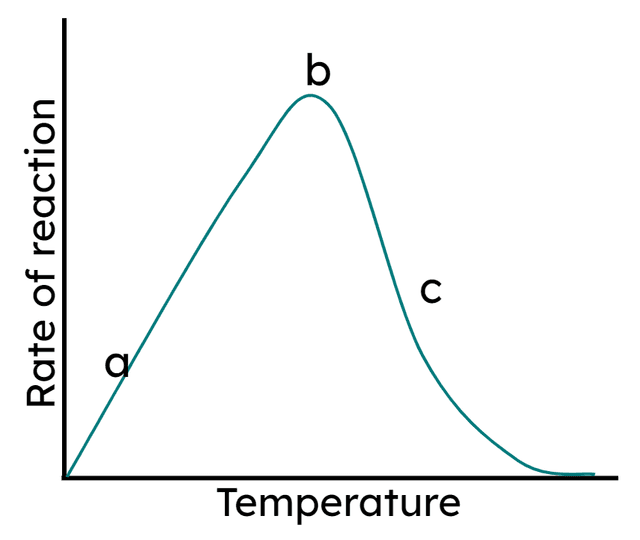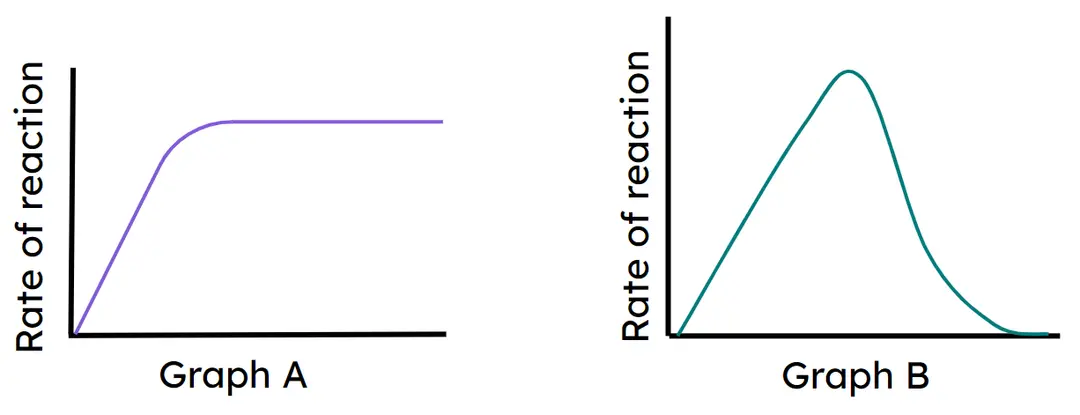Myths about teaching can hold you back
- Year 10
- Edexcel
- Foundation
Effects of substrate concentration and temperature on rate of enzyme activity
I can explain how the rate of an enzyme reaction is affected by substrate concentration and temperature.
- Year 10
- Edexcel
- Foundation
Effects of substrate concentration and temperature on rate of enzyme activity
I can explain how the rate of an enzyme reaction is affected by substrate concentration and temperature.
These resources will be removed by end of Summer Term 2025.
Switch to our new teaching resources now - designed by teachers and leading subject experts, and tested in classrooms.
These resources were created for remote use during the pandemic and are not designed for classroom teaching.
Lesson details
Key learning points
- The rate of a reaction is the amount of change (e.g. substrate broken down or product made) per unit of time.
- Enzyme reaction rate increases as substrate concentration increases, until an optimum when all active sites are full.
- Enzyme reaction rate increases with temperature due to more collisions, until an optimum when all active sites are full.
- Enzyme reaction rate decreases as temperature increases above the optimum, as the active site becomes denatured.
- Interpretation of graphs showing effects of substrate concentration and temperature on enzyme reaction rate.
Keywords
Rate of reaction - A measure of the amount of change that occurs per unit of time.
Concentration - A measure of the quantity of a dissolved substance in a given volume of solution.
Optimum - The conditions under which the maximum rate of reaction occurs.
Denatured - A permanent change in the shape of an enzyme that stops it from working properly.
Common misconception
Enzymes die rather than denature.
The word denature is clearly introduced and a CfU explores the word die vs denature.
To help you plan your year 10 combined science lesson on: Effects of substrate concentration and temperature on rate of enzyme activity, download all teaching resources for free and adapt to suit your pupils' needs...
To help you plan your year 10 combined science lesson on: Effects of substrate concentration and temperature on rate of enzyme activity, download all teaching resources for free and adapt to suit your pupils' needs.
The starter quiz will activate and check your pupils' prior knowledge, with versions available both with and without answers in PDF format.
We use learning cycles to break down learning into key concepts or ideas linked to the learning outcome. Each learning cycle features explanations with checks for understanding and practice tasks with feedback. All of this is found in our slide decks, ready for you to download and edit. The practice tasks are also available as printable worksheets and some lessons have additional materials with extra material you might need for teaching the lesson.
The assessment exit quiz will test your pupils' understanding of the key learning points.
Our video is a tool for planning, showing how other teachers might teach the lesson, offering helpful tips, modelled explanations and inspiration for your own delivery in the classroom. Plus, you can set it as homework or revision for pupils and keep their learning on track by sharing an online pupil version of this lesson.
Explore more key stage 4 combined science lessons from the Biological molecules and enzymes unit, dive into the full secondary combined science curriculum, or learn more about lesson planning.

Equipment
Content guidance
- Risk assessment required - equipment
Supervision
Adult supervision required
Licence
Prior knowledge starter quiz
6 Questions
Q1.What type of molecule are enzymes?
Q2.True or false? Enzymes can affect the rate of a reaction.
Q3.Enzymes the amount of activation energy needed for a reaction to take place.

Q4.What region on an enzyme does the substrate bind to?

Q5.What can be said about the shape of the active site and the substrate shape?
Q6.Put the steps in order to show how an enzyme works.
Assessment exit quiz
6 Questions
Q1.True or false? The concentration of substrate will affect the rate of reaction.
Q2.At high temperatures the shape of the enzyme's active site can change, and it no longer fits the substrate. We say the enzyme has become ...
Q3.Match the labels to what is happening.

there are fewer successful collisions so the reaction rate is lower.
all active sites are full and reaction rate is as high as it can be.
the enzyme is denatured. The reaction cannot be catalysed.
Q4.Which part of an enzyme does the substrate need to collide with for a reaction to take place?
Q5.What is the rate of reaction?
Q6.Below are two graphs showing the rates of enzyme facilitated reactions. Match the graph to the factor affecting the rate of reaction.

Graph B
Graph A


